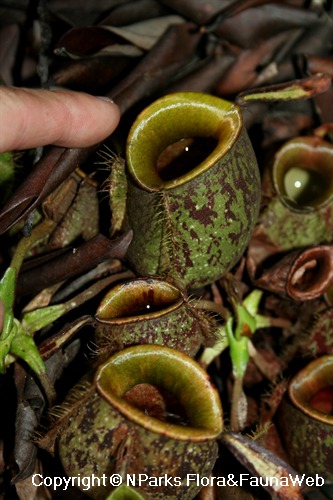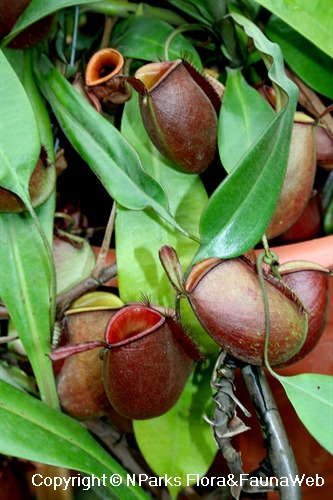
Back
Nepenthes ampullaria Jack (Brunei Red)
| Family Name: | Nepenthaceae |
| Synonyms: | Nepenthes ampullacea |
| Common Name: | Tropical Pitcher Plant, Narrow-lid Pitcher Plant, Periok Kera, 猪笼草 |
Name
Classifications and Characteristics
| Plant Division | Angiosperms (Flowering Seed Plants) (Dicotyledon) |
|---|---|
| Plant Growth Form | Climber, Creeper, Herbaceous Plant |
| Lifespan (in Singapore) | Perennial, Semi-Annual / Annual-Like |
| Mode of Nutrition | Autotrophic, Heterotrophic (Insectivorous / Carnivorous) |
| Plant Shape | Irregular |
Biogeography
| Native Distribution | Brunei, Malaysia (Borneo) |
|---|---|
| Native Habitat | Terrestrial (Primary Rainforest, Disturbed Area / Open Ground) |
| Preferred Climate Zone | Tropical |
Description and Ethnobotany
| Others - Plant Morphology | Herbaceous to semi-woody carnivorous vine, usually up to 6m high or spread. Native to tropical lowland peat swamp forests, Leaves lanceolate to spoon-shaped, sessile (stalkless), glossy green when mature, velvety reddish-brown when young. Leaf tips terminate in coiling tendrils, which under ideal conditions are modified into prey-catching pitchers. In nature, pitchers are partially filled with rainwater enriched with digestive enzymes secreted by glands on waxy internal wall. Lower pitchers usually 5cm tall by 3cm across, globose and squatly urn-like, with short hairy keels on outer wall, and massed together side by side into basal rosettes. Pitcher lids atypically narrow and back-flipped, do not cover pitcher mouth (unlike those of other Nepenthes species). Normally sold in trade as tissue-cultured clones of "Brunei Red" form discovered in Brunei and Borneo. Pitchers dark red (or sometumes red speckled with green), with similar colouration for corrugated peristome (mouth). Resembles the more expensive Cantley's Red and William's Red cultivars.Plant is diocecious, with male and female flowers found on separate plants. Flowers small, yellow, clustered into panicle inflorescences up to 45cm across. Blooming occurs once or twice per year, lasting for several weeks.Often cultivated as an oddity plant in pots or hanging baskets, and in concept gardens for its decorative pitchers. Also suitable in air-conditioned areas, as long as plant is enclosed within humid terrarium. Grows well under bright indirect sunlight. Prefers moist, poor-nutrient acidic media like peatmoss, sphagnum moss or salt-free cocopeat. Avoid fertilizing, especially with fast-release fertilizers, which may burn or kill the plant, or result in excessive foliage growth without pitcher formation. Propagate by seeds (variable progenies), or stem cuttings. If taking tip cuttings, use 4-node cuttings (tip plus 3 lower leaves) to prevent tender growing tip from rotting before establishment. Single-node cuttings from lower parts of the plant are also possible. Basal rosettes joined by underground runners can be divided and potted up separately.Genus epithet 'Nepenthes' means 'no sorrow' or 'banished sorrow', based on the ancient Greek name of another plant that apparently relieves grief and produces euphoria, and used here in connection with the reported medicinal qualities of some Nepenthes species. Species epithet ampullaria' means 'flask-shaped', a reference to the pitchers. |
|---|---|
| Ethnobotanical Uses | Others: Attractive red pitchers can be used for floral arrangements. Whole plant can be used as unconventional auspicious deco during festive seasons. |
Landscaping Features
| Desirable Plant Features | Ornamental Foliage |
|---|---|
| Landscape Uses | Suitable for Hanging Baskets, Interiorscape/ Indoor Plant, General, Focal Plant, Terrarium, Container Planting |
| Thematic Landscaping | Carnivorous Garden, Naturalistic Garden |
Fauna, Pollination and Dispersal
| Seed or Spore Dispersal | Abiotic (Explosive Dehiscence), Biotic (Fauna) |
|---|
Plant Care and Propagation
| Light Preference | Semi-Shade |
|---|---|
| Water Preference | Moderate Water, Occasional Misting |
| Plant Growth Rate | Slow |
| Rootzone Tolerance | Easy to Grow, Poor Infertile Soils, Acidic (low pH) Soils |
| Maintenance Requirements | Low |
| Pruning | Pruning usually not needed, unless to obtain stem-cuttings for propagation. |
| Fertilizing | Avoid fertilizing, especially with high-analysis fast-release fertilizers, as these may burn / kill the plant., or result in lots of foliage lacking in pitcher formation. If need be, use diluted strength of weak organic fertilizers (eg. orchid-type fertilizers, Osmocote). |
| Propagation Method | Seed, Stem Cutting, Stolon / Runner, Division |
| Propagule Establishment Remarks | Pot cuttings up in nutrient-poor media, eg. salt-free cocopeat, peatrmoss or spaghum moss. Keep media moist and do not allow it to dry out. |
| Maintenance Requirements Remarks | If kept away from rain, try to fill the pitchers with rainwater up to half the pitcher's depth. |
| Propagation Method Remarks | If taking tip cuttings, use 4-node cuttings (growing tip and 3 leaves below) to prevent tender tip from rottting before establishment. Single-node cuttings possible from lower parts of the plant. Multiple basal rosettes can be divided by cutting underground runners. |
Foliar
| Foliage Retention | Drought / Semi-Deciduous |
|---|---|
| Mature Foliage Colour(s) | Green |
| Mature Foliage Texture(s) | Smooth, Glossy / Shiny, Leathery, Thick |
| Foliar Modification | Pitcher Trap |
| Foliar Type | Simple / Unifoliate |
| Foliar Arrangement Along Stem | Alternate |
| Foliar Shape(s) | Non-Palm Foliage (Oblong) |
| Foliar Venation | Parallel |
| Foliar Margin | Entire |
| Foliar Apex - Tip | Acute |
| Foliar Base | Truncate / Square |
| Typical Foliar Area | Microphyll ( 2.25cm2 - 20.25 cm2 ), Notophyll ( 20.25cm2 - 45 cm2 ) |
| Prominent Young Flush Colour(s) Remarks | Furry reddish-brown |
Non - Foliar and Storage
| Bark Colour(s) | Light brown |
|---|---|
| Mature Bark Texture | Peeling / Flaking / Papery |
| Stem Type & Modification | Woody, Herbaceous, Runner / Stolon |
| Root Type | Underground (Fibrous Root) |
| Mature Bark Texture Remarks | Corky bark on woody stems |
Floral (Angiosperm)
| Flower & Plant Sexuality | Unisexual Flowers , Dioecious |
| Flower Colour(s) | Yellow / Golden |
|---|
| Flower Symmetry | Radial |
| Flower Size - Remarks | Small, held in inflorescence. |
| Inflorescence Type | Panicle |
| Flower Lifespan on Plant | Several Days |
| Flowering Habit | Polycarpic |
Fruit, Seed and Spore
| Mature Fruit Colour(s) | Brown |
|---|---|
| Fruit Classification | Simple Fruit |
| Fruit Type | Dehiscent Dry Fruit , Capsule |
Image Repository
Others
| Master ID | 29130 |
|---|---|
| Species ID | 3439 |
| Flora Disclaimer | The information in this website has been compiled from reliable sources, such as reference works on medicinal plants. It is not a substitute for medical advice or treatment and NParks does not purport to provide any medical advice. Readers should always consult his/her physician before using or consuming a plant for medicinal purposes. |

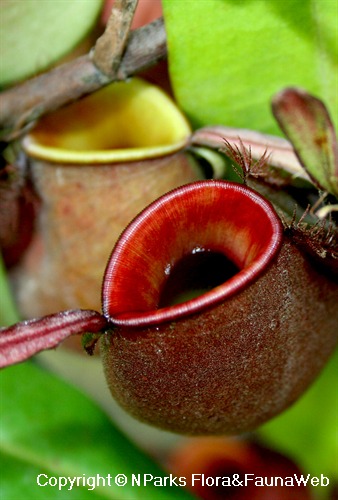
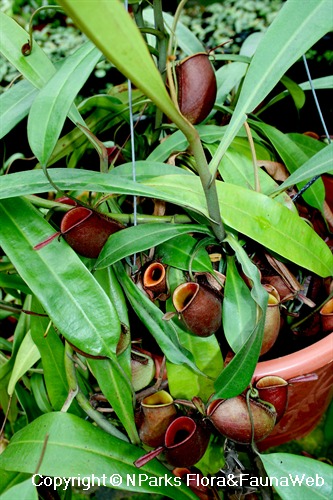
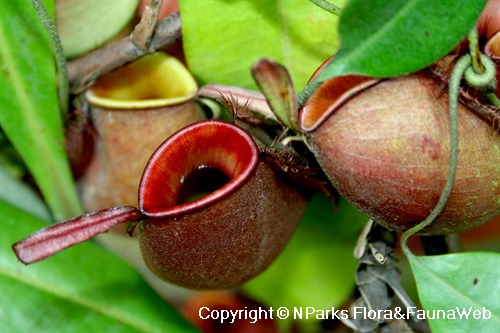
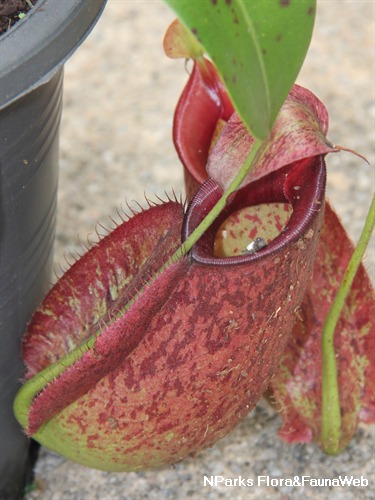
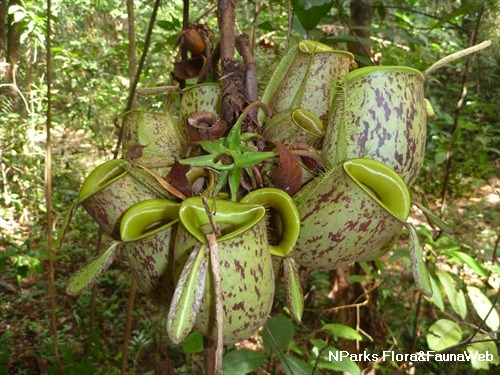
.jpg)
